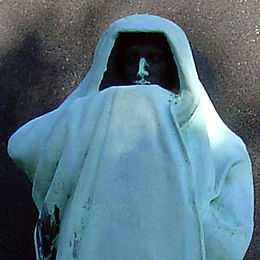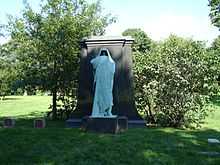Eternal Silence (sculpture)
|
Dexter Graves Monument | |
 | |
|
According to folklore looking into the eyes of the statue will give the viewer a vision of their own death. | |
| Location | Chicago, Cook County, Illinois, USA |
|---|---|
| Built | 1909 |
| Built by | Jules Bercham |
| Architectural style | Art Nouveau |
| Sculptor | Lorado Taft |
| Governing body | Graceland Cemetery |
| Part of | Graceland Cemetery (#00001628) |
| Added to NRHP | January 18, 2001 |
Eternal Silence, alternatively known as the Dexter Graves Monument or the Statue of Death,[1] is a monument in Chicago's Graceland Cemetery. It is a bronze sculpture set on and backdropped by black granite. It was created by American sculptor Lorado Taft in 1909.
History
Eternal Silence is a monument in Graceland Cemetery to Dexter Graves, who led a group of thirteen families who moved to Chicago from Ohio in 1831.[2] He died in 1844, and the monument was commissioned from sculptor Lorado Taft in 1909 by Graves' son Henry Graves.[3] In Ada Bartlett Taft's 1946 Lorado Taft; Sculptor and Citizen, it was listed as one of his most important works.[4] Images of Eternal Silence have been used in other artworks, including works by Claes Oldenburg.[4] One folktale claims that if an unsuspecting viewer were to look into the eyes of Eternal Silence's hooded figure, the viewer would be shown a vision of his or her own death.[1]
Design

Eternal Silence has been called "eerie",[3] "somber",[3] "grim-looking",[5] "mysterious",[6] and "haunting".[6] The bronze figure, based on traditional depictions of the Grim Reaper, is set against a black granite base and stands 10 feet (3.0 m) tall upon that base.[3] The black granite provides contrast for the bronze statue, which is heavily oxidized because of its age.[3][7] The hooded figure was influenced by Taft's own "ideas on death and silence".[4] Historically speaking, the figure in Eternal Silence is related to the sculpted funeral procession around the tomb of Philip the Bold in Dijon, France and the Adams Memorial by Augustus Saint-Gaudens in Washington, D.C.[4] The statue is considered famous and has been noted as Graceland Cemetery's most "unforgettable" monument.[1][3][7] The monument was designed by Taft and cast by Jules Bercham.[8][9] On its base, Taft inscribed the north side with his signature; the south side is inscribed with Am. Art Bronze Foundry J. Bercham -Chicago-.[3] The monument falls within Art Nouveau style.[4]
See also
Notes
- ↑ 1.0 1.1 1.2 Bielski, Ursula. Creepy Chicago: A Ghosthunter's Tale of the City's Scariest Sites, (Google Books link), Lake Claremont Press, 2003, p. 93, (ISBN 1893121151).
- ↑ Lanctot. Barbara, ‘’A Walk Through Graceland Cemetery: A Chicago Architecture Foundation Walking Tour’’, A Chicago Architecture Foundation Walking Tour, Chicago, IL, 1992 P. 6
- ↑ 3.0 3.1 3.2 3.3 3.4 3.5 3.6 Kiefer, et al., pp. 68–69.
- ↑ 4.0 4.1 4.2 4.3 4.4 Kiefer, et al., pp. 146–47.
- ↑ Cutler, Irving. Chicago: Metropolis of the Mid-Continent, (Google Books link), SIU Press, 2006, p. 285, (ISBN 0809327023).
- ↑ 6.0 6.1 Sinkevitch, Alice. AIA Guide to Chicago, (Google Books link), Houghton Mifflin Harcourt, 2004 p. 227, (ISBN 0156029081).
- ↑ 7.0 7.1 Cohn, Scottie. Chicago Curiosities: Quirky Characters, Roadside Oddities & Other Offbeat Stuff, (Google Books link), Globe Pequot, 2011, pp. 86–87, (ISBN 0762759844).
- ↑ "Graceland Cemetery, Graves Monument", Property Information Report, HAARGIS Database, Illinois Historic Preservation Agency, accessed October 8, 2011.
- ↑ Kiefer, et al., p. 132.
References
- Kiefer, Charles D., Achilles, Rolf, and Vogel, Neil A. "Graceland Cemetery" (pdf), National Register of Historic Places Registration Form, HAARGIS Database, Illinois Historic Preservation Agency, June 18, 2000, accessed October 8, 2011.